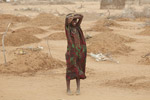
A girl stands in front of freshly dug graves in Dadaab, Kenya. The town was one of the places Somali refuges fled to during the 2011 famine, but many didn’t make it. Most of the dead were children. Photo by: Andy Hall/Oxfam East Africa/Creative Commons 2.0.
Four years after over a quarter of a million people perished in a famine in Somalia, the East African country is again on the verge of a possible humanitarian disaster. Flooding in southern Somalia, following months of little rain, has just exacerbated an already-precarious situation according to the Food and Agricultural Organization (FAO). The group is calling for $49 million to provide emergency funding to programs already in place to stem the crisis.
“We have a small and critical window of opportunity—we must seize it now if we want to avoid going the same way as four years ago,” said Luca Alinovi, the acting Head of Office at the FAO Somalia.
In all, the United Nations estimate that a million people in Somalia are in need of assistance. The group also reports that 218,000 children in the country under five are already acutely malnourished.
“If we’ve learned anything from the devastation of the 2011 famine, it’s that early warning signs must lead to immediate action,” said Bukar Tijani, FAO Assistant Director-General and Regional Representative for Africa. “We know from experience that quick responses to early warnings are crucial to prevent disaster and are less costly than emergency responses to full-blown humanitarian crisis.”
Experts fear the new crisis could become the second famine in the country in just a few years. In 2011 a potent combination of conflict with extremist groups, failed governance, poor rainfall, and high food prices led to the worst famine worldwide in a quarter of a century. A report several years after the fact found that it was much more destructive than believed, killing 258,000 people, including 133,000 children under five.
“There is consensus that the humanitarian response to the famine was mostly late and insufficient, and that limited access to most of the affected population, resulting from widespread insecurity and operating restrictions imposed on several relief agencies, was a major constraint,” the 2013 report read.
Poor rains this year in the country’s grain belts led to lower-than-expected harvests, in addition to water scarcity and livestock problems. Current flooding however now threatens to overrun crops grown along rivers, worsening the situation. The poor crop situation has led to a spike in food prices, an issue in other parts of Africa as well.
Climate change may also be playing a role as well. Some recent research has suggested that warming in the western Pacific and Indian oceans could be helping to drive recent droughts in eastern Africa, but more research is likely needed. That said, the most recent Intergovernmental Panel on Climate Change (IPCC) report finds that climate change will very likely lead to worsening droughts in the drier parts of Africa.

Undernourishment by percentage. Note that Somalia is categorized as missing or insufficient data. Graph courtesy of FAO. Click to enlarge.
Related articles
From triumph to tragedy: famine could hit world’s newest country by August
(07/08/2014) Suffering from a six month civil war, the world’s youngest country could begin experiencing famine conditions in the next few weeks, according to an analysis from a group of British aid agencies.
Somalia could face another famine due to delayed rains, insecurity

(05/05/2014) Nearly a million people are in need of immediate food assistance in Somalia, where delayed rains, high food prices, and insecurity threaten a repeat of the 2011 famine that left 258,000 people dead. According to the UN’s Food Security and Nutrition Analysis Unit (FSNAU), 857,000 Somalis need immediate assistance.
Wild food: scientists link forests to human nutrition

(04/25/2014) Food security is a mounting global issue. As a solution to increasing food scarcity, forests are commonly cleared to make land available for agriculture. Around the world, both industrial farmers and subsistence farmers alike are growing crops on deforested land. However, scientists are finding that the forests themselves may actually be key to providing local populations with higher quality diets.

(03/31/2014) It’s not just melting glaciers and bizarrely-early Springs anymore; climate change is impacting every facet of human civilization from our ability to grow enough crops to our ability to get along with each other, according to a new 2,300-page report from the Intergovernmental Panel on Climate Change (IPCC). The massive report states definitively that climate change is already affecting human societies on every continent.
Dietary diversity: key to defending tropical ecosystems
(03/06/2014) A new study published in the Proceedings of the National Academy of
Sciences (PNAS) points to the homogenization of global diets over the past
fifty years. It shows that worldwide production of traditional staples
such as millet, rye, sorghum, yams and cassava have been in decline.
Instead, the world’s population increasingly relies on a relatively
small number of ‘megacrops’ like wheat, corn and soy, raising
serious concerns for global food security, human nutrition, and the
genetic diversity of crops.
20 million people face hunger in Africa’s Sahel region
(02/04/2014) The UN and partner humanitarian groups today called on the international community to spend $2 billion to avoid a famine in Africa’s Sahel region, which includes nine nations along the southern edge of the Sahara. Although the Sahel is chronically prone to food insecurity, the situation has dramatically worsened as the UN estimates 20 million people are at risk of hunger up from 11 million last year.